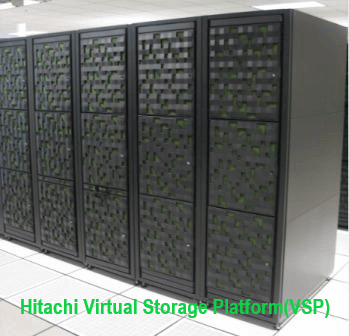Hitachi VSP Introduction
Hitachi Virtual Storage Platform (VSP)

The Hitachi Virtual Storage Platform(VSP ) is a high-capacity, high-performance, large-scale, enterprise-class SAN storage system.
The main advantage of the Hitachi Virtual storage platform (VSP) is its 3D scaling capability.
What is 3D Scaling Technology in VSP?
Hitachi Virtual storage platform (VSP) can be scaled in 3 ways and it is called 3D scaling.
- VSP can scale Up (hardware within a chassis) for increased performance and connectivity
- VSP can scale Out (dual chassis arrays) for doubled internal capacity, connectivity, and performance
- VSP can scale Deep (external arrays) for virtualization (addition of tier‐2 and tier‐3 performance and capacity)
Scale Up
Scale up means we can add additional cache, processors, and DKUs ports within the basic single chassis array configuration non-descriptively to improve the performance of VSP.
Scale out
The VSP’s scalability can be greatly extended (doubled) by adding an additional control unit (DKC).
Scale Out
Scale out means other storage systems can be connected to VSP as external storage.
It is capable to connect and manage external virtualized storage. Other vendor storage systems are also supported to be connected to VSP as external virtualized storage. VSP supports up to 247 PB of virtualized external storage.
Hitachi Virtual Storage Platform Overview
The Hitachi Virtual Storage Platform(VSP) is a high-capacity, high performance, large-scale, enterprise-class data storage system.
A fully configured VSP is a 6 rack system that includes two controller chassis, up to 2048 HDD drives (if all drives are 2-1/2 inch drives) or up to 1280 HDD drives (if all drives are 3-1/2 inch drives), up to 256 SSD drives, up to 96 Flash Module Drives, and a total of 1TB cache and maximum physical disk capacity of approximately 2.5 PB per full storage system.
In addition to the number of disks, the system can be configured with disk drives of different capacities and speeds, varying numbers of FEDs and BEDs, and varying cache capacities, as follows:
- The total number of FEDs and BEDs slots is 12.
- Maximum of 12 Front end directors (FEDs) can be placed if there are no BEDs installed as in a diskless system.
- Maximum of 8 Back end directors (BEDs) can be placed. In this case, only two FEDs will be installed.
- Cache memory capacity: 512 GB per controller (DKC), and 1TB per two controllers (DKCs).
- Supported HDD (disk) drives with capacities of 146 GB, 300 GB, 600 GB, 900 GB, 2 TB, and 3 TB.
- Supported Flash drive capacities of 200 GB and 400 GB with ultra-high speed response.
- Supported Flash modules with a capacity of 1.6 TB and 3.2 TB with response times faster than SSDs.
- Disk drives speeds are 7,200, 10,000, or 15,000 RPM.
- High speed data transfer between the BED and HDDs at a rate of 6 GB/s with the SAS interface
- High speed quad core(4 cores) CPUs that provide three times the performance of a Universal Storage Platform V/VM storage system.
- The VSP supports up to 65,280 logical volumes.
- Supports both Mainframe: Fibre Channel (FICON), Open system: Fibre Channel.
- Supported RAID types are
- RAID6 (6D+2P)
- RAID5 (3D+1P/7D+1P)
- RAID1 (2D+2D/4D+4D)
- All the main system components are configured in redundant pairs. If one of the components in a pair fails, the other/alternate component performs the functions alone until the failed component is replaced. Meanwhile, the storage system continues its normal operation.
Non-disruptive service and upgrades
The Virtual Storage Platform(VSP) storage system is designed so that service and upgrades can be performed without interrupting normal operations. These features include:
- Main components are “hot swappable” — can be added, removed, and replaced without any disruption — while the storage system is in operation. The front & rear fan assemblies can be moved out of the way to enable access to physical disks and other components, but not both at the same time. There is no time limit on changing physical drives because either the front or rear fans cool the unit while the other fan assembly is turned off and moved out of the way.
- A Service Processor(SVP) mounted on the controller chassis monitors the running condition of the system. Connecting the Service Processor(SVP) with a service center enables remote maintenance.
- The firmware(microcode) can be upgraded without disrupting the operations of the storage system. The firmware is stored in shared memory (part of the cache memory module(CMA)) & transferred in a batch, reducing the number of transfers from the SVP to the controller chassis via the LAN. This increases the speed of upgrading the firmware online because it works with two or more processors at the same time.

